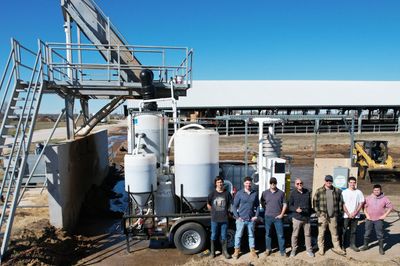future of farming
Why this growing Chilean clean energy company moved its HQ to Houston

Lignium combats greenhouse gasses with a green fuel that boasts an enviably low carbon footprint. Photo courtesy of Lignium
In Houston, air pollution is usually more of an abstract concept than a harsh reality. But in parts of Chile, the consequences of heating homes with wet wood are catching up to residents.
“Given all the contamination, there are times kids aren’t allowed to go to school. The air pollution is really affecting people’s health,” says Agustín Ríos, COO of Lignium Energy.
Additionally, the methane and nitrous oxide produced by cattle farming are a problem. But Lignium Energy, an international company started in Chile and now headquartered in Houston’s Greentown Labs, has a solution that can solve both problems by upending the latter.
“There’s a lack of solutions with the problem of manure. Methane gases are destroying our planet,” says CEO and co-founder Enrique Guzmán. He goes on to say that most solutions currently being developed are expensive and complex. But not Lignium Energy’s method, invented by co-founder José Antonio Caraball.
Caraball has patented an extraordinarily simple concept. Lignium separates the solid from liquid excretions, then cleans the solid to generate a hay-like biomass. Biomass refers to organic matter that can be used as fuel. What Lignium makes from the cattle evacuations is a clean, odorless and highly calorific biomass.
Essentially, Lignium combats greenhouse gasses with a green fuel that boasts an enviably low carbon footprint. “Our process is very cheap and very simple. That’s why we are a great solution,” explains Guzmán.
Caraball, an industrial engineer, came up with the idea six years ago, says Guzmán. Five years ago, he began working with the company, one year ago, Guzmán and Ríos picked up and moved to Houston.
“We decided to move out of Chile due to market size,” says Ríos. However, the product is already being sold to consumers in its homeland.
Why Houston? The reason was twofold. As an energy company, Ríos says that they wanted to be in “the energy capital of the world.” But Texas is also one of the largest sites of cattle farming on the planet. Lignium prefers to work with farms with more than 500 head to optimize harvesting the waste that becomes biomass.
With that in mind, Lignium has partnered with Southwest Regional Dairy Center in Stephenville, Texas, a little more than an hour southwest of Fort Worth, a town known as the world’s rodeo capital. The facility is associated with Texas A&M, though Guzmán says Lignium is not officially associated with the university.
Guzmán says that the company is currently hiring a team member to help Lignium figure out commercial logistics, as well as four or five other Houstonians who will help them take their product to market in the United States, and eventually around the globe. For now, he predicts that they will be able to sell to consumers in this country by early next year, if not the fourth quarter of 2023.
“We are very committed to the solution because, at the end of the day, if we do good work with the company, we are sure we can give better conditions to the cattle industry,” says Guzmán. “Then we can make a big impact on a real problem.
------
This article originally ran on InnovationMap.